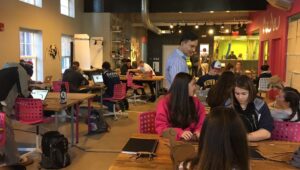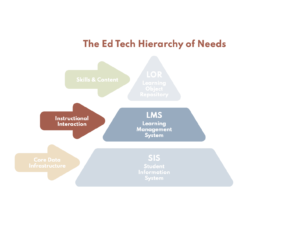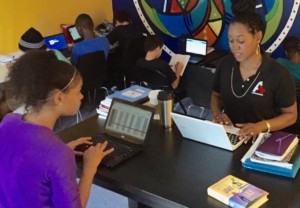Disrupting Pedagogy – Part 2

In my previous post, I talked about how subtle shifts in developing digital learning materials – content, apps, services, games, videos – can help disrupt pedagogy as practiced in most schools and help students learn more independently, more deeply, and more authentically. From an educator perspective this shift is akin to changing from pedagogies based in direct instruction to constructivism. From a technology perspective it is akin to the shift from structured to object-oriented programming. In either case, it is hard for those who are unused to the distinctions to see the difference. Therefore, until such time as there are assessments that measure and show clearly the outcomes of such approaches beyond immediate impact on summative test scores, it is imperative to identify the markets where such innovations can evolve and to create incentives for meaningful innovation.
There are three obvious potential markets:
- Parents who are homeschooling or supplementing formal schooling with the intent to provide their children with not only the skills to pass college entrance exams but with richer skills for success in a complex, connected world and workplace: creativity, collaboration, communication, growth mindset, questing disposition, happiness, grit, perseverance, curiosity, self-organization, self-ownership of learning, agency, or whatever combination of values they feel are lacking in public school systems that have narrowed down their measure of success to summative test scores and college enrollment (not that those aren’t also important.)
- Individual teachers and classrooms where they have the freedom to purchase the apps and services that will best serve their students at a given time. Teachers who have the freedom to evolve and refine their practice also have the judgment to look for value in more than one dimension. Many of them are also connected educators who share what they learn in their digital communities.
- On-line schools. Perhaps the best potential market, accelerator, and incubator for innovative digital content and tools are the on-line schools.
The best of on-line schools are already disrupting schooling in certain dimensions.
High quality organizations, such as Florida Virtual School, have successfully challenged many of the constraints of traditional schooling such as seat-time and grade-based cohorts. Already, FLVS offers students the opportunity to learn in a mastery-based environment – precisely the kind of subtle shift that supports students in owning their learning, rather than simply “being taught.”
FLVS students move through middle or high school materials at their own pace. Rather than listening to a teacher lecture once, students access on-line content that they can review and repeat and supplement as needed until they have a strong understanding of the material. Students demonstrate their understanding in multiple ways – through discussion with high quality, empathetic teachers, through on-line assessments, through producing work in formats left to student choice, or through collaborative projects with other students. Students have the opportunity to use assessment as a learning experience: in many cases if students are dissatisfied with their performance they have the opportunity to retake tests (since they are computer-generated, the questions on the tests are random and new tests can be created with the touch of a button) or redo assignments. The philosophy is to ensure that students master material before moving on, rather than to label them as deficient and force them to move on to new materials before they are ready. In some areas, FLVS is even challenging traditional pedagogy and experimenting with game-based learning.
Despite their important innovations, on-line schools are still often tied to a direct-instruction curriculum due to a dearth of great digital products in the market, but their mastery-based culture creates a fertile environment for introducing content that is rich in context and developing student understanding of the organizing principles of important fields, rather than the surface structures that are assessed in summative testing. This experimentation, this willing to learn through trial and error guided by professional judgment, this culture of focusing on helping children to flourish beyond the narrow metrics of summative test scores make on-line schools such as FLVS an ideal place for new pedagogies to incubate and accelerate.
If.
And only if, innovators develop digital content that supports authentic pedagogy – and that provides sufficient context for students to understand, not just memorize – and then make that available for adoption and co-evolution within on-line schools and other smaller markets.
Digital content, services, and tools that let student struggle with questions before feeding them answers – these are a new area, a young technology if you will. This is why, according to the model of disruptive innovation, they will best take root and grow within an integrated solution such as the online school. Digital offerings that seek to support kids in their growth in numerous dimensions, in deep understanding, in developing positive dispositions to hard work and challenging learning will have to be hybrid innovations. In addition to offering value in other dimensions, they also have to be part of an integrated solution that meets the traditional high-end metrics of public schooling: summative test scores and college enrollment statistics. These key characteristics of successful, transformative digital solutions are largely misunderstood by startups hoping to serve education. As a result, we see little today that is new or transformative.
The constraints of the education market tends to stifle innovation in ways that are too numerous to count. They force would-be innovators to behave like moribund incumbents. And yet, those specific challenges also leave tremendous opportunities on the table for those startups who are not only innovative with technology, but deeply insightful with education theory and science, and deeply empathetic toward parents, students, and educators. It is time to invest less in those companies and approaches that offer nothing more than simple efficiencies and to invest more in those that support the subtle shift from teaching to learning, from direct instruction to constructivist practices, from superficial test-passing to deep understanding.
The technology is good enough to create such tools. And perhaps the integrated, yet disruptively inclined world of on-line or virtual schools is the place where these tools can mature to the point where they can disrupt the rest of the education market for the better.





0 Comments
Leave a Comment
Your email address will not be published. All fields are required.